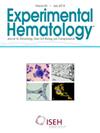NAMPT-mediated deacetylation of HCLS1 protein promotes clonogenic growth of pediatric CML cells
IF 2.1
4区 医学
Q2 HEMATOLOGY
引用次数: 0
Abstract
Pediatric chronic myeloid leukemia (CML) is a rare hematologic malignancy with biological features that differ from that of adult patients. In pediatric patients with CML the burden of tumor cells is higher resulting in a delayed achievement of deep molecular response (DMR) upon treatment with tyrosine kinase inhibitors (TKIs, e.g., imatinib) than what has been reported in adults. Therefore, the probability to develop resistance to TKIs in children with CML is higher than in adults due to much longer exposure to TKIs. Moreover, in children with CML, long-term treatment with imatinib causes hematologic and nonhematologic toxicities. Improvements of CML therapy in pediatric patients based on the targeting of hematopoiesis-specific BCR::ABL1 downstream effectors are needed. Here, we report elevated levels of the nicotinamide phosphoribosyltransferase (NAMPT) in mononuclear cells of pediatric patients with chronic phase CML (CP-CML) and in blastic phase CML cell lines. NAMPT inhibition abrogated in vitro clonogenic capacity and proliferation of CML cells. NAMPT deacetylates and activates the hematopoietic-specific lyn-substrate 1 (HCLS1) protein, which is essential for the proliferation of CML cells. Moreover, IL1RAP – a marker of myeloid leukemia-initiating cells – and LEF-1 – a transcription factor of Wnt signaling – are downstream targets of NAMPT/HCLS1 pathway. Together, our results reveal new treatment avenues of pediatric patients with CML by targeting NAMPT-mediated deacetylation of the hematopoietic-specific HCLS1 protein.
nampt介导的HCLS1蛋白去乙酰化促进儿童CML细胞的克隆生长。
小儿慢性髓性白血病(CML)是一种罕见的血液系统恶性肿瘤,其生物学特征与成人患者不同。在儿科CML患者中,肿瘤细胞的负担更高,导致酪氨酸激酶抑制剂(TKIs,例如伊马替尼)治疗延迟实现深度分子反应(DMR),而不是在成人中报道。因此,由于长期暴露于TKIs, CML患儿对TKIs产生耐药性的概率高于成人。此外,在患有CML的儿童中,长期使用伊马替尼会引起血液学和非血液学毒性。基于造血特异性BCR::ABL1下游效应物的儿科CML治疗需要改进。在这里,我们报告了慢性CML (CP-CML)儿科患者和母细胞期CML细胞系的单核细胞中烟酰胺磷酸核糖基转移酶(NAMPT)水平升高。NAMPT抑制抑制CML细胞的体外克隆生成能力和增殖。NAMPT脱乙酰并激活造血特异性lyn-substrate 1 (HCLS1)蛋白,这是CML细胞增殖所必需的。此外,髓性白血病起始细胞的标志物IL1RAP和Wnt信号的转录因子LEF-1是NAMPT/HCLS1通路的下游靶点。总之,我们的研究结果揭示了针对nampt介导的造血特异性HCLS1蛋白去乙酰化的儿科CML患者的新治疗途径。摘要儿童慢性髓性白血病(CML)患者需要长期酪氨酸激酶抑制剂治疗,但会引起毒性。因此,需要改进儿科患者的CML治疗。在这里,我们报告了慢性期儿童CML细胞中烟酰胺磷酸核糖基转移酶(NAMPT)水平升高。NAMPT抑制抑制CML细胞的体外克隆生成能力和增殖。NAMPT脱乙酰并激活造血特异性lyn-substrate 1 (HCLS1)蛋白。此外,髓系白血病起始细胞的标志物IL1RAP是NAMPT/HCLS1通路的下游靶点。总之,我们的结果揭示了儿科CML患者的新治疗途径。
本文章由计算机程序翻译,如有差异,请以英文原文为准。
求助全文
约1分钟内获得全文
求助全文
来源期刊

Experimental hematology
医学-血液学
CiteScore
5.30
自引率
0.00%
发文量
84
审稿时长
58 days
期刊介绍:
Experimental Hematology publishes new findings, methodologies, reviews and perspectives in all areas of hematology and immune cell formation on a monthly basis that may include Special Issues on particular topics of current interest. The overall goal is to report new insights into how normal blood cells are produced, how their production is normally regulated, mechanisms that contribute to hematological diseases and new approaches to their treatment. Specific topics may include relevant developmental and aging processes, stem cell biology, analyses of intrinsic and extrinsic regulatory mechanisms, in vitro behavior of primary cells, clonal tracking, molecular and omics analyses, metabolism, epigenetics, bioengineering approaches, studies in model organisms, novel clinical observations, transplantation biology and new therapeutic avenues.
 求助内容:
求助内容: 应助结果提醒方式:
应助结果提醒方式:


